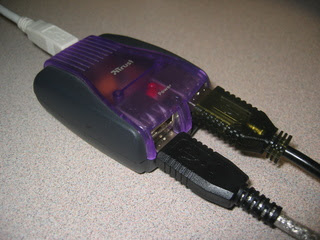
USB compared to other standards
Storage
A Flash Drive, a typical USB mass-storage device
USB implements connections to storage devices using a set of standards called the USB mass-storage device class. This was initially intended for traditional magnetic and optical drives, but has been extended to support a wide variety of devices. USB is not intended to be a primary bus for a computer's internal storage: buses such as ATA (IDE), Serial ATA (SATA), and SCSI fulfill that role.
However, USB has one important advantage in making it possible to install and remove devices without opening the computer case, making it useful for external drives. Today, a number of manufacturers offer external, portable USB hard drives, or empty enclosures for drives, that offer performance comparable to internal drives. These external drives usually contain a translating device that interfaces a drive of conventional technology (IDE, ATA, SATA, ATAPI, or even SCSI) to a USB port. Functionally, the drive appears to the user just like another internal drive.
Storage
A Flash Drive, a typical USB mass-storage device
USB implements connections to storage devices using a set of standards called the USB mass-storage device class. This was initially intended for traditional magnetic and optical drives, but has been extended to support a wide variety of devices. USB is not intended to be a primary bus for a computer's internal storage: buses such as ATA (IDE), Serial ATA (SATA), and SCSI fulfill that role.
However, USB has one important advantage in making it possible to install and remove devices without opening the computer case, making it useful for external drives. Today, a number of manufacturers offer external, portable USB hard drives, or empty enclosures for drives, that offer performance comparable to internal drives. These external drives usually contain a translating device that interfaces a drive of conventional technology (IDE, ATA, SATA, ATAPI, or even SCSI) to a USB port. Functionally, the drive appears to the user just like another internal drive.















No comments:
Post a Comment